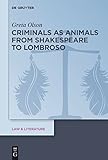Criminals as Animals from Shakespeare to Lombroso / Greta Olson.
Material type: TextSeries: Law & Literature ; 8Publisher: Berlin ; Boston : De Gruyter, [2013]Copyright date: ©2014Description: 1 online resource (354 p.)Content type:
TextSeries: Law & Literature ; 8Publisher: Berlin ; Boston : De Gruyter, [2013]Copyright date: ©2014Description: 1 online resource (354 p.)Content type: - 9783110339772
- 9783110339840
- 820.93556 22/ger
- HV6030
- online - DeGruyter
- Issued also in print.
| Item type | Current library | Call number | URL | Status | Notes | Barcode | |
|---|---|---|---|---|---|---|---|
 eBook
eBook
|
Biblioteca "Angelicum" Pont. Univ. S.Tommaso d'Aquino Nuvola online | online - DeGruyter (Browse shelf(Opens below)) | Online access | Not for loan (Accesso limitato) | Accesso per gli utenti autorizzati / Access for authorized users | (dgr)9783110339840 |
Browsing Biblioteca "Angelicum" Pont. Univ. S.Tommaso d'Aquino shelves, Shelving location: Nuvola online Close shelf browser (Hides shelf browser)
Frontmatter -- Acknowledgements -- Contents -- List of Illustrations -- List of Abbreviations -- Chapter 1. Introduction: Tracing the History of the Criminal-Animal Metaphor -- Part I: Creating ‘Criminal Beasts’ in Early Modern Literature and Law -- Chapter 2. Catching Conies with Thomas Harman, Robert Greene, and Thomas Dekker -- Chapter 3. Richard III’s Animalistic Criminal Body -- Chapter 4. Of a Howling Murderer – The Duke of Malfi -- Chapter 5. Ben Jonson’s Comedies of Gulling Rogues -- Part II: Humanizing Animals and ‘Animalizing’ the Lower Orders during the Long Eighteenth Century -- Introduction to Part II Eighteenth-Century Changes in the Criminal-Animal Trope -- Chapter 6. Colonialism and the ‘Criminal Beast’ in Robinson Crusoe and Gulliver’s Travels -- Chapter 7. William Hogarth’s The Four Stages of Cruelty – Sympathizing with Animals and Denigrating the Lower Orders as Beasts -- Chapter 8. The Prisoner as Suffering Animal – Caleb Williams’s Revision of the Criminal-Animal Metaphor -- Part III: Reinstating the ‘Criminal Beast’ during the Nineteenth Century -- Introduction to Part III The Nineteenth Century’s Delineation of the Criminal Class -- Chapter 9. Charles Dickens’s Contradictions -- Chapter 10. The Criminal-Animal Metaphor and Lombrosian Criminology -- Chapter 11. Coda -- Bibliography -- Index
restricted access online access with authorization star
http://purl.org/coar/access_right/c_16ec
Criminals as Animals from Shakespeare to Lombroso demonstrates how animal metaphors have been used to denigrate persons identified as criminal in literature, law, and science. Its three-part history traces the popularization of the 'criminal beast' metaphor in late sixteenth-century England, the troubling of the trope during the long eighteenth century, and the late nineteenth-century discovery of criminal atavism. With chapters on rogue pamphlets, Shakespeare, Webster, Jonson, Defoe and Swift, Godwin, Dickens, and Lombroso, the book illustrates how ideologically inscribed metaphors foster transfers between law, penal practices, and literature. Criminals as Animals concludes that criminal-animal metaphors continue to negatively influence the treatment of prisoners, suspected terrorists, and the poor even today.
Issued also in print.
Mode of access: Internet via World Wide Web.
In English.
Description based on online resource; title from PDF title page (publisher's Web site, viewed 28. Feb 2023)









